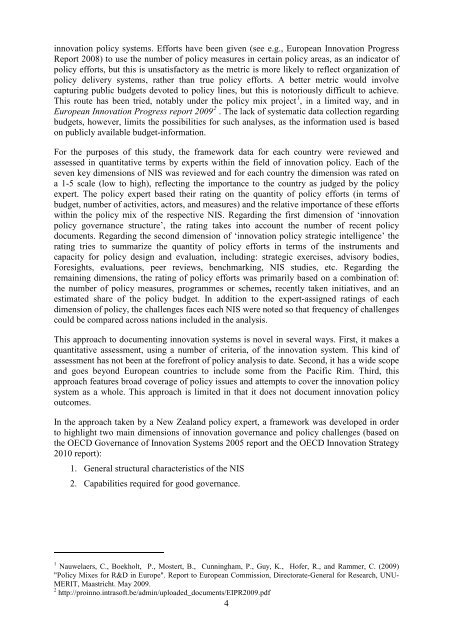Comparison of innovation policies in selected European, Asian and ...
Comparison of innovation policies in selected European, Asian and ...
Comparison of innovation policies in selected European, Asian and ...
You also want an ePaper? Increase the reach of your titles
YUMPU automatically turns print PDFs into web optimized ePapers that Google loves.
<strong><strong>in</strong>novation</strong> policy systems. Efforts have been given (see e.g., <strong>European</strong> Innovation Progress<br />
Report 2008) to use the number <strong>of</strong> policy measures <strong>in</strong> certa<strong>in</strong> policy areas, as an <strong>in</strong>dicator <strong>of</strong><br />
policy efforts, but this is unsatisfactory as the metric is more likely to reflect organization <strong>of</strong><br />
policy delivery systems, rather than true policy efforts. A better metric would <strong>in</strong>volve<br />
captur<strong>in</strong>g public budgets devoted to policy l<strong>in</strong>es, but this is notoriously difficult to achieve.<br />
This route has been tried, notably under the policy mix project 1 , <strong>in</strong> a limited way, <strong>and</strong> <strong>in</strong><br />
<strong>European</strong> Innovation Progress report 2009 2<br />
. The lack <strong>of</strong> systematic data collection regard<strong>in</strong>g<br />
budgets, however, limits the possibilities for such analyses, as the <strong>in</strong>formation used is based<br />
on publicly available budget-<strong>in</strong>formation.<br />
For the purposes <strong>of</strong> this study, the framework data for each country were reviewed <strong>and</strong><br />
assessed <strong>in</strong> quantitative terms by experts with<strong>in</strong> the field <strong>of</strong> <strong><strong>in</strong>novation</strong> policy. Each <strong>of</strong> the<br />
seven key dimensions <strong>of</strong> NIS was reviewed <strong>and</strong> for each country the dimension was rated on<br />
a 1-5 scale (low to high), reflect<strong>in</strong>g the importance to the country as judged by the policy<br />
expert. The policy expert based their rat<strong>in</strong>g on the quantity <strong>of</strong> policy efforts (<strong>in</strong> terms <strong>of</strong><br />
budget, number <strong>of</strong> activities, actors, <strong>and</strong> measures) <strong>and</strong> the relative importance <strong>of</strong> these efforts<br />
with<strong>in</strong> the policy mix <strong>of</strong> the respective NIS. Regard<strong>in</strong>g the first dimension <strong>of</strong> ‘<strong><strong>in</strong>novation</strong><br />
policy governance structure’, the rat<strong>in</strong>g takes <strong>in</strong>to account the number <strong>of</strong> recent policy<br />
documents. Regard<strong>in</strong>g the second dimension <strong>of</strong> ‘<strong><strong>in</strong>novation</strong> policy strategic <strong>in</strong>telligence’ the<br />
rat<strong>in</strong>g tries to summarize the quantity <strong>of</strong> policy efforts <strong>in</strong> terms <strong>of</strong> the <strong>in</strong>struments <strong>and</strong><br />
capacity for policy design <strong>and</strong> evaluation, <strong>in</strong>clud<strong>in</strong>g: strategic exercises, advisory bodies,<br />
Foresights, evaluations, peer reviews, benchmark<strong>in</strong>g, NIS studies, etc. Regard<strong>in</strong>g the<br />
rema<strong>in</strong><strong>in</strong>g dimensions, the rat<strong>in</strong>g <strong>of</strong> policy efforts was primarily based on a comb<strong>in</strong>ation <strong>of</strong>:<br />
the number <strong>of</strong> policy measures, programmes or schemes, recently taken <strong>in</strong>itiatives, <strong>and</strong> an<br />
estimated share <strong>of</strong> the policy budget. In addition to the expert-assigned rat<strong>in</strong>gs <strong>of</strong> each<br />
dimension <strong>of</strong> policy, the challenges faces each NIS were noted so that frequency <strong>of</strong> challenges<br />
could be compared across nations <strong>in</strong>cluded <strong>in</strong> the analysis.<br />
This approach to document<strong>in</strong>g <strong><strong>in</strong>novation</strong> systems is novel <strong>in</strong> several ways. First, it makes a<br />
quantitative assessment, us<strong>in</strong>g a number <strong>of</strong> criteria, <strong>of</strong> the <strong><strong>in</strong>novation</strong> system. This k<strong>in</strong>d <strong>of</strong><br />
assessment has not been at the forefront <strong>of</strong> policy analysis to date. Second, it has a wide scope<br />
<strong>and</strong> goes beyond <strong>European</strong> countries to <strong>in</strong>clude some from the Pacific Rim. Third, this<br />
approach features broad coverage <strong>of</strong> policy issues <strong>and</strong> attempts to cover the <strong><strong>in</strong>novation</strong> policy<br />
system as a whole. This approach is limited <strong>in</strong> that it does not document <strong><strong>in</strong>novation</strong> policy<br />
outcomes.<br />
In the approach taken by a New Zeal<strong>and</strong> policy expert, a framework was developed <strong>in</strong> order<br />
to highlight two ma<strong>in</strong> dimensions <strong>of</strong> <strong><strong>in</strong>novation</strong> governance <strong>and</strong> policy challenges (based on<br />
the OECD Governance <strong>of</strong> Innovation Systems 2005 report <strong>and</strong> the OECD Innovation Strategy<br />
2010 report):<br />
1. General structural characteristics <strong>of</strong> the NIS<br />
2. Capabilities required for good governance.<br />
1 Nauwelaers, C., Boekholt, P., Mostert, B., Cunn<strong>in</strong>gham, P., Guy, K., H<strong>of</strong>er, R., <strong>and</strong> Rammer, C. (2009)<br />
"Policy Mixes for R&D <strong>in</strong> Europe". Report to <strong>European</strong> Commission, Directorate-General for Research, UNU-<br />
MERIT, Maastricht. May 2009.<br />
2 http://pro<strong>in</strong>no.<strong>in</strong>tras<strong>of</strong>t.be/adm<strong>in</strong>/uploaded_documents/EIPR2009.pdf<br />
4

















